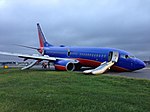Delta Air Lines Flight 1086

Delta Air Lines Flight 1086 was a scheduled Delta Air Lines domestic passenger flight between Atlanta and New York's LaGuardia Airport. On March 5, 2015, the McDonnell Douglas MD-88 aircraft veered off the runway shortly after landing at LaGuardia Airport in New York City. The plane ran up the seawall berm and struck the perimeter fence, sliding along it for approximately 940 feet (290 m) before coming to rest with the nose of the aircraft hanging over the berm above Flushing Bay. There were no fatalities, although 24 people suffered minor injuries. The aircraft was seriously damaged and written off.The final report by the NTSB found the probable cause of the accident was the pilot's "inability to maintain directional control of the airplane due to his application of excessive reverse thrust, which degraded the effectiveness of the rudder in controlling the airplane's heading.": 76
Excerpt from the Wikipedia article Delta Air Lines Flight 1086 (License: CC BY-SA 3.0, Authors, Images).Delta Air Lines Flight 1086
Terminal C Post-Security, New York Queens
Geographical coordinates (GPS) Address Nearby Places Show on map
Geographical coordinates (GPS)
| Latitude | Longitude |
|---|---|
| N 40.776 ° | E -73.863305555556 ° |
Address
Terminal C Post-Security
11369 New York, Queens
New York, United States
Open on Google Maps








